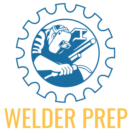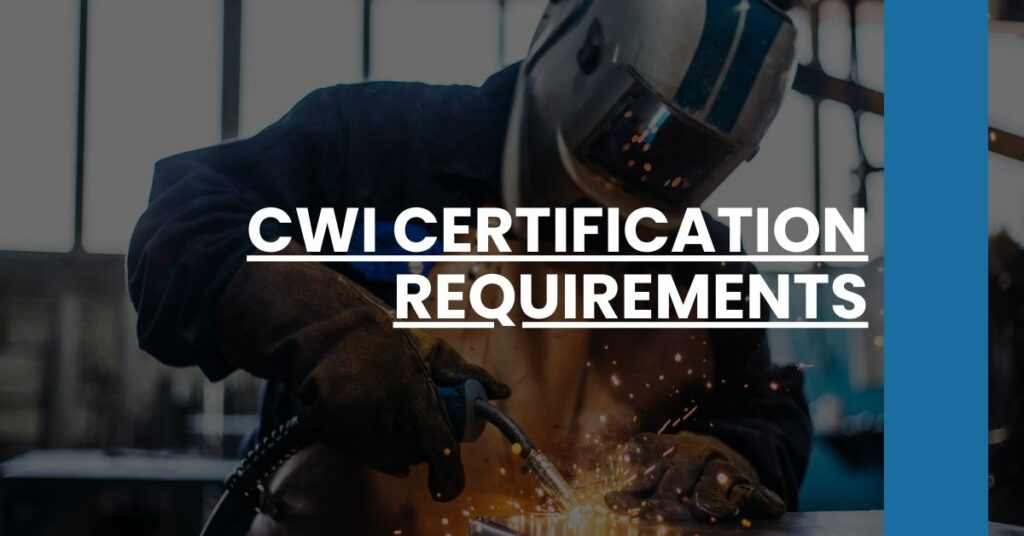Certified Welding Inspector (CWI) certification from the American Welding Society (AWS) has specific requirements you need to meet.
Here’s what you need:
- Education and Experience: Varies from a high school diploma with 5 years of experience to a bachelor’s degree with 1 year.
- Vision Test: Must pass a vision acuity test.
- Exam: Pass a three-part exam covering welding fundamentals, practical application, and code book proficiency.
- Documentation: Detailed proof of education and work experience.
Pursuing a CWI certification is a great way to advance your welding career and ensure the highest standards in the industry.
Understanding CWI Certification
The Certified Welding Inspector (CWI) certification, provided by the American Welding Society (AWS), holds significant importance in the welding industry. It endorses the knowledge and skills necessary to ensure the quality and integrity of welded structures. CWIs are responsible for inspecting welds to confirm they meet specific codes and standards.
Since its establishment in 1959, the AWS has certified over 40,000 professionals globally. This vast number underscores the certification’s robustness and prestige. Obtaining this certification boosts individual careers and fortifies safety and quality in welding operations across various industries, from construction to aerospace.
The Role and Responsibilities of a CWI
A CWI has several key responsibilities:
- Inspecting Welds: Ensure that welds conform to specific codes and standards.
- Record Keeping: Maintain detailed records of weld inspections.
- Communication: Convey findings to stakeholders to ensure compliance with technical specifications.
A Certified Welding Inspector also needs to stay updated with industry standards. This vigilance is crucial for maintaining high safety and quality standards in projects they oversee.
Ethical Standards
Certified Welding Inspectors adhere to a strict code of ethics outlined by the AWS. This code includes maintaining professionalism, ensuring integrity and honesty in inspections, and continuous professional development. Such ethical adherence is crucial for fostering trust and reliability in the industry.
Eligibility Requirements for CWI Certification
The eligibility requirements for CWI certification offer various pathways based on your education and experience. AWS structures these pathways to accommodate professionals from different educational backgrounds.
Educational and Experience Criteria
Here are the primary criteria for eligibility:
- High School Diploma: Requires at least five years of welding-related experience.
- Associate Degree in Welding Technology: Reduces the required experience to three years.
- Bachelor’s Degree in Welding Engineering or Technology: Only one year of relevant experience is necessary.
This inclusive approach ensures that people from diverse educational backgrounds can attain CWI certification.
Vision Acuity Test
Passing an eye examination is mandatory to ensure you can accurately perform weld inspections. Precision in detecting weld flaws and assessing quality is paramount, and AWS mandates this test to maintain high industry standards.
Documenting Experience
Your work experience needs thorough documentation. Previous employers or clients must verify these records. Such verification ensures that candidates possess extensive hands-on experience crucial for effective weld inspections.
Age and Character Requirements
Candidates must be at least 18 years old. Additionally, AWS emphasizes the importance of integrity and good moral character, which is often backed by references from previous employers.
The CWI Exam: Structure and Content
The CWI certification exam is divided into three parts, each focusing on different aspects of welding inspection knowledge and skills.
Part A: Fundamentals
Part A consists of 150 questions that cover the basics:
- Welding Processes
- Inspection Methods
- Welding Terminology
- Safety Protocols
Key topics include welding symbols, destruction testing methods, and material properties. This section ensures a strong foundational knowledge of welding theories and applications.
Part B: Practical Application
Part B requires hands-on inspection of welding samples. This practical approach evaluates your ability to identify and assess weld discontinuities, utilizing various inspection tools.
- Interpret Welding Procedure Specifications (WPS)
- Perform Macro-Etch Tests
- Conduct Bend Tests
- Visual Inspection: Identify defects like porosity or cracks.
Your ability to apply theoretical knowledge in a practical setting is critical to passing this part of the exam.
Part C: Code Book Applications
Part C involves open-book questions based on a specific welding code (e.g., AWS D1.1, API 1104). This section tests your ability to navigate and apply code requirements to practical scenarios.
- Code Interpretation
- Project Specification Analysis
- Standards Compliance
The examination’s rigorous nature ensures candidates have a comprehensive understanding and practical skills necessary for effective welding inspections.
Preparing for the CWI Exam
Efficient preparation for the CWI exam is crucial for success. AWS offers many resources that can greatly aid your study process.
Study Materials and Resources
AWS provides various resources:
- Certification Manual for Welding Inspectors: A comprehensive guide covering all exam topics.
- AWS Seminars and Online Courses: These sessions provide in-depth knowledge and hands-on practice, foundational for mastering exam content.
- Practice Exams: Regular self-assessment keeps you on track and helps identify areas requiring further study.
Hands-On Experience
Practical experience in welding inspection is invaluable. Familiarizing yourself with the relevant codes and standards through real-world applications enriches your understanding and proficiency.
Study Groups and Mentorship
Forming or joining study groups can be beneficial. Discussing complex topics and sharing resources with peers can enhance learning. Additionally, seeking mentorship from experienced CWIs can provide insights and practical tips.
Focusing on Weak Areas
Identify weaker areas through practice exams and allocate more study time to these topics. Doing this ensures a well-rounded understanding of all examination areas. Emphasizing hands-on practice along with theoretical study provides a balanced and thorough preparation strategy.
Plan Your Study Schedule
Create a study schedule that covers all sections methodically. Consistency is key. Breaking down study sessions into manageable chunks ensures comprehensive coverage without overwhelming you.
By understanding the CWI certification requirements and dedicating focused effort to preparation, you can achieve this prestigious accreditation and elevate your welding career.
Application Process
Completing the Application
To start your journey toward CWI certification, you need to complete the application process:
- Complete the Application Form: Available on the AWS website, this form captures your educational background and work experience. Fill it out accurately to avoid any delays.
- Attach Documentation: Include proof of your education, signed verification of work experience, and vision acuity test results. This documentation verifies your eligibility.
- Submit the Application: Send the completed application, required documentation, and application fee to AWS. The fee may vary based on your AWS membership status.
- Schedule the Exam: After AWS approves your application, they will provide information about available exam dates and locations. Choose a convenient date and location to take the exam.
By following these steps carefully, you ensure a smooth application process.
Ensuring Accuracy and Avoiding Delays
Double-check your application to ensure you have included all required information and documentation. Inaccurate or incomplete applications can lead to delays and additional fees. Submit your application well in advance to secure your preferred exam date and location.
Fee Structure and Membership Benefits
AWS offers different fee structures for members and non-members. Becoming an AWS member can save you money on application fees. Additionally, membership provides access to numerous resources, including training materials and industry publications that can aid in your exam preparation.
Maintaining and Renewing Your CWI Certification
Certification Validity and Renewal Process
Your CWI certification remains valid for three years. To maintain your certification, you must renew it at the end of this period. The renewal process involves:
- Submitting Proof of Professional Development: This includes attending AWS seminars, publishing articles, or continuing education in welding.
- Vision Acuity Test: Similar to the initial certification process, you must pass a vision acuity test to confirm your ability to perform accurate weld inspections.
Recertification Every Nine Years
After nine years, CWIs must go through a recertification process. There are two options for recertification:
- Recertification Examination: Retake and pass the entire CWI exam.
- Continuing Education: Meet specific continuing education requirements approved by AWS.
These options ensure that certified welding inspectors remain knowledgeable and skilled, keeping up with advancements in welding technology and standards.
Importance of Continuous Professional Development
Continuous professional development is crucial for maintaining your skills and knowledge. Attend industry conferences, workshops, and training sessions to stay updated with new welding techniques, materials, and standards. Additionally, networking with other CWIs can provide valuable insights and support.
Career Benefits of CWI Certification
Enhanced Job Opportunities
Achieving CWI certification significantly boosts your career prospects. Industries such as construction, aerospace, and manufacturing highly value Certified Welding Inspectors for their expertise in ensuring weld quality and compliance with safety standards. CWIs often work in quality control, inspection, and project management roles, which offer diverse and rewarding career paths.
Higher Salary Prospects
Certified Welding Inspectors typically earn higher salaries compared to non-certified welders. The certification demonstrates your advanced skills and knowledge, making you a valuable asset to employers. According to industry surveys, CWIs can earn significantly more, reflecting the demand for their specialized skills.
Professional Credibility and Reputation
Holding a CWI certification enhances your professional credibility and reputation. Clients and employers recognize the certification as a mark of quality and reliability. This recognition can lead to more job opportunities and career advancement, positioning you as an expert in the field.
Career Advancement and Growth
CWI certification also opens doors to career advancement. Certified Welding Inspectors can move into supervisory or managerial roles, leveraging their expertise in quality assurance and compliance. The certification’s prestige also makes it easier to transition into specialized areas within the welding industry.
Conclusion
CWI certification is a valuable credential that enhances your career opportunities in the welding industry. By meeting the eligibility requirements, passing the exam, and maintaining certification through continuous professional development, you can advance your career and contribute to high-quality welding standards. Start your journey toward CWI certification to enjoy numerous professional benefits and thrive in the ever-evolving welding industry.

